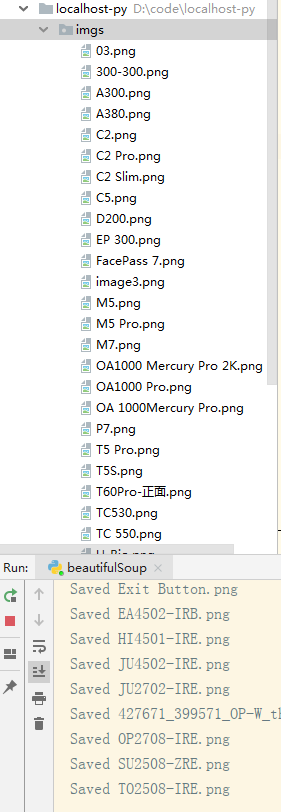安装:
pip3 install beautifulsoup4
pip install beautifulsoup4
Beautifulsoup4 解析器使用 lxml,原因为,解析速度快,容错能力强,效率够高
安装解析器:
pip install lxml
使用方法:
- 加载 beautifulsoup4 模块
- 加载 urllib 库的 urlopen 模块
- 使用 urlopen 读取网页,如果是中文,需要添加 utf-8 编码模式
- 使用 beautifulsoup4 解析网页
#coding: utf8 #python 3.7 from bs4 import BeautifulSoup from urllib.request import urlopen #if chinese apply decode() html = urlopen("https://www.anviz.com/product/entries/1.html").read().decode('utf-8') soup = BeautifulSoup(html, features='lxml') all_li = soup.find_all("li",{"class","product-subcategory-item"}) for li_title in all_li: li_item_title = li_title.get_text() print(li_item_title)
Beautifulsoup4文档: https://www.crummy.com/software/BeautifulSoup/bs4/doc.zh/#id13
方法同 jQuery 类似:
//获取所有的某个标签:soup.find_all('a'),find_all() 和 find() 只搜索当前节点的所有子节点,孙子节点 find_all() soup.find_all("a") //查找所有的标签 soup.find_all(re.compile("a")) //查找匹配包含 a 的标签 soup.find_all(id="link2") soup.find_all(href=re.compile("elsie")) //搜索匹配每个tag的href属性 soup.find_all(id=True) //搜索匹配包含 id 的属性 soup.find_all("a", class_="sister") //搜索匹配 a 标签中 class 为 sister soup.find_all("p", class_="strikeout") soup.find_all("p", class_="body strikeout") soup.find_all(text="Elsie") //搜索匹配内容为 Elsie soup.find_all(text=["Tillie", "Elsie", "Lacie"]) soup.find_all("a", limit=2) //当搜索内容满足第2页时,停止搜索 //获取tag中包含的文本内容 get_text() soup.get_text("|") soup.get_text("|", strip=True) //用来搜索当前节点的父辈节点 find_parents() find_parent() //用来搜索兄弟节点 find_next_siblings() //返回所有符合条件的后面的兄弟节点 find_next_sibling() //只返回符合条件的后面的第一个tag节点 //用来搜索兄弟节点 find_previous_siblings() //返回所有符合条件的前面的兄弟节点 find_previous_sibling() //返回第一个符合条件的前面的兄弟节点 find_all_next() //返回所有符合条件的节点 find_next() //返回第一个符合条件的节点 find_all_previous() //返回所有符合条件的节点 find_previous() //返回第一个符合条件的节点 .select() 方法中传入字符串参数,即可使用CSS选择器的语法找到tag soup.select("body a") soup.select("head > title") soup.select("p > a") soup.select("p > a:nth-of-type(2)") soup.select("#link1 ~ .sister") soup.select(".sister") soup.select("[class~=sister]") soup.select("#link1") soup.select('a[href]') soup.select('a[href="http://example.com/elsie"]') .wrap() 方法可以对指定的tag元素进行包装 [8] ,并返回包装后的结果
爬取 anviz 网站产品列表图片: demo
使用了
BeautifulSoup
requests
os
#Python 自带的模块有以下几个,使用时直接 import 即可 import json import random //生成随机数 import datetime import time import os //建立文件夹
#coding: utf8 #python 3.7 from bs4 import BeautifulSoup import requests import os URL = "https://www.anviz.com/product/entries/2.html" html = requests.get(URL).text os.makedirs("./imgs/",exist_ok=True) soup = BeautifulSoup(html,features="lxml") all_li = soup.find_all("li",class_="product-subcategory-item") for li in all_li: imgs = li.find_all("img") for img in imgs: imgUrl = "https://www.anviz.com/" + img["src"] r = requests.get(imgUrl,stream=True) imgName = imgUrl.split('/')[-1] with open('./imgs/%s' % imgName, 'wb') as f: for chunk in r.iter_content(chunk_size=128): f.write(chunk) print('Saved %s' % imgName)

爬取的这个 URL 地址是写死的,其实这个网站是分三大块的,末尾 ID 不一样,还没搞明白怎么自动全爬。